How do musicians make money in 2025? This in-depth guide covers everything you need to know about royalties, revenue streams, and so much more.
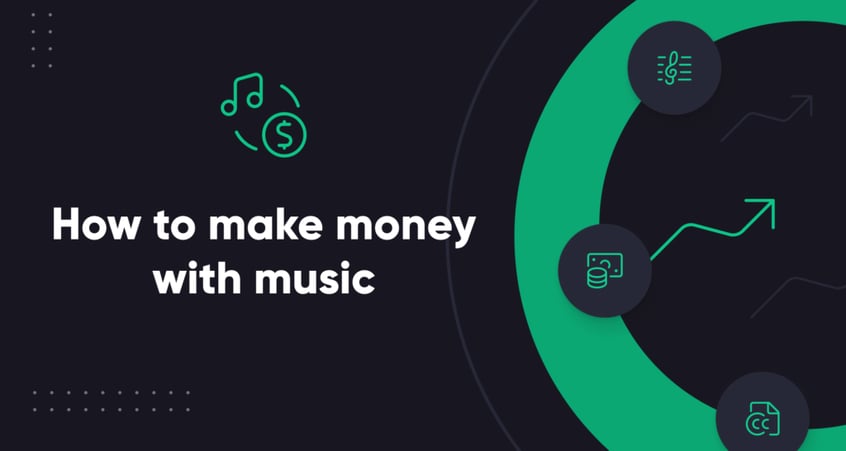
It’s probably safe to say that music is one of your life’s main passions, but wouldn’t it be perfect to turn that passion into a steady and reliable income source as well? Many artists, musicians, and songwriters resign themselves to making music simply for the love of the craft, which is enough for some. Monetizing your music might seem complicated or risky without a little guidance and planning.
The good news is that now more than ever, there are so many avenues to explore. Whether you’re a composer, producer, or singer, it’s important to know your options when it comes to making money with your music. From in-person gigs and merch to digital distribution and marketing, there’s a good chance you can discover a way to level up your music income.
In this guide, we’ll give you an overview of how to get paid for your music, the different revenue streams involved, how to turn music into your full-time career, and much more.
Jump to a section:
- What are copyrights, royalties, and music licensing?
- How do music creators make money?
- How to increase your chances of making money with music full-time
- 16 ways to make money with your music
1. What are copyrights, royalties, and music licensing?
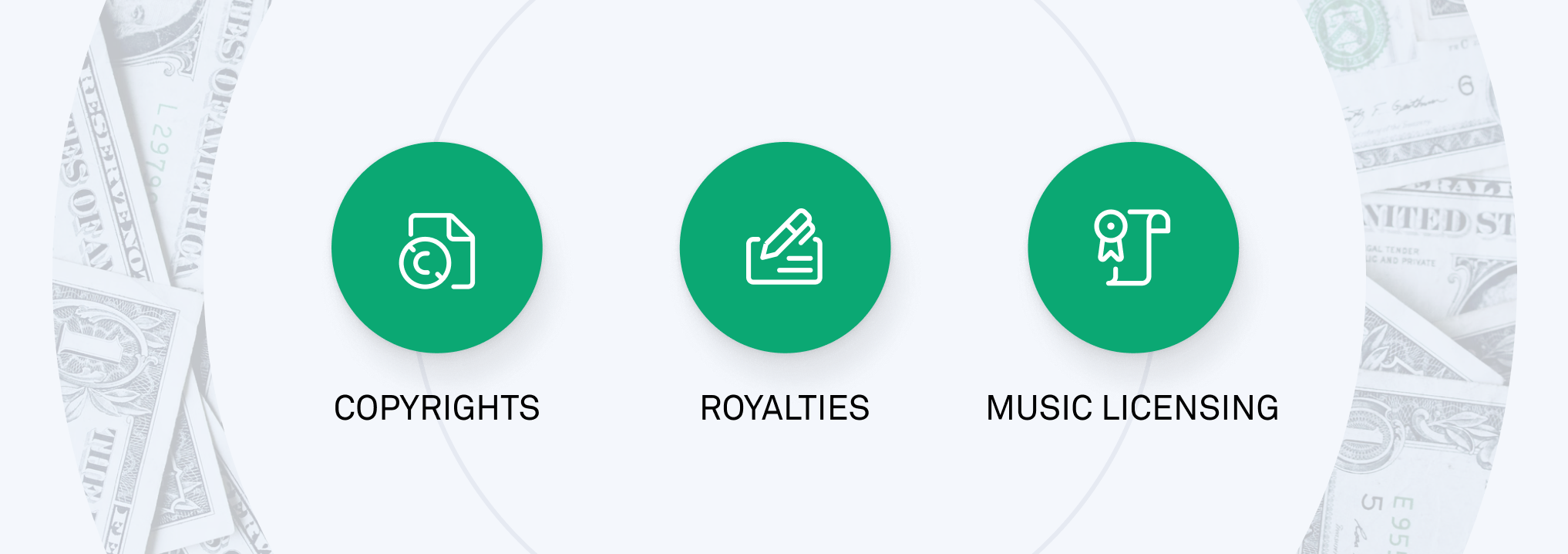
If you’ve been making music for more than a few days, you’ve probably heard the term “royalty.” At its most basic, a royalty is how musicians get paid. Songwriters, recording artists, composers, and other copyright holders like publishers all get paid a royalty for the use of their works.
The works can be recorded songs (often called “masters”) or their underlying compositions—and how they generate royalties can vary. It’s crucial to understand your rights as a music creator, as this is the foundation for getting paid.
We’ll soon discuss a few of the ways you can make money with your own works, but first we need to talk about the backbone of it all: copyrights.
Music copyrights
There are two types of copyrights that reflect the two “sides” of every song:
Publishing rights belong to the songwriters and/or composers of a song. This refers to anything involved with the actual musical composition, such as the lyrics, melody, chords, and other pieces of the song itself.
Master rights belong to the owner of a “master” recording, or the sound recording, of an underlying composition. These rights generally belong to whoever financed a recording, whether it’s an independent artist or a record label.
When a master is made of a songwriter’s composition, the songwriter also earns publishing rights.
If you own the copyright to a song (chances are high that you do if you wrote the song), you have the exclusive right to do all of the following with your composition:
- Reproduce the copyrighted work (pressing CDs, vinyl, digital downloads, streaming, etc.)
- Prepare derivative works based upon the work (creating remixes, cover songs, etc. using all or part of the copyrighted work)
- Distribute copies of the work to the public (selling or sharing the work yourself, or via a music distributor, label, or other service)
- Publicly perform the copyrighted work (performing your work live in a public setting)
- Publicly play the copyrighted work (playing the work on the radio, including streaming and satellite radio, online, etc.)
- Publicly display the copyrighted work (displaying lyrics or other physical media pertaining to the work)
Collectively, these rights serve the dual function of protecting your original work and allowing you to make money from your music.
Now, you as the copyright holder have the right to sell or transfer your copyright. But let’s assume for now that you’re hanging onto your copyrights and want to earn royalties from them.
Making money with music royalties
Generally speaking, if you write or record music, you will earn royalties from it. Songwriters and publishers will earn royalties related to that underlying composition, whereas artists, labels, and even distributors (depending on the type of deal worked out in artist agreements) will earn royalties based on recordings.
Let’s take a look at the different types of royalties in the US music industry, and how to earn them.
Publishing royalties
Songwriters earn royalties when the underlying composition of a song is utilized, whether it’s in a recorded track, sync deal, or even a public performance. Generally, these earnings are split 50/50 between the writer (or co-writers) and the music publishing company.
If you want to earn the entire royalty on opportunities like sync and performance, however, you can be your own music publisher. Just make sure that you’re registered as both in your relevant performing rights organization (more on that in just a second).
Mechanical royalties
In the past, the word “mechanical” was interchangeable with “physical.” These royalties largely came from sales of vinyl, CDs, cassettes, and other tangible media. But as the music industry evolved, mechanical royalties expanded to include digital downloads and streaming as well.
You can think of mechanical royalties as any reproduction of your work. Whenever your songs are reproduced and/or sold, you will earn a statutory mechanical royalty. The current rate is 9.1 cents for songs up to five minutes, and then 1.75 cents per minute (or fraction of a minute) over five minutes. This rate can be negotiated if you’re working with an outside company, like a record label.
Public performance royalties
These royalties are earned when your music is played publicly, whether it’s at a live concert, on a bar jukebox, in a restaurant, or on your favorite FM station. Make sure you’re registered with a performing rights organization (PRO), which collects and distributes these royalties on your behalf.
The three biggest PROs in the US are BMI, ASCAP, and SESAC. If you live outside of the US in a country that observes copyright, you’ll be able to find your local equivalent and sign up with them.
Sync royalties
When you license your music to be used with visual media—like films, commercials, TV shows, video games, or advertisements—you earn a sync (or synchronization) royalty. For example, if your song is used in an episode of your favorite television show, you’ll earn a royalty every time that episode airs. More on this shortly.
Print music royalties
Calling all composers! Although this form of royalty was much more common in the past, it still applies to sheet music and is based on the number of copies made. So if one of your songs is picked by a high school marching band for its halftime show performance, you’ll earn royalties from the sheet music distributed.
Music licensing
When you give an outside party the right to use your music copyright, you typically grant them a license to do so. Royalties themselves don’t come from licensing; rather, they’re earned through how that licensing is used. For example, if your song is licensed by a soda company for a commercial, they will typically pay you a licensing fee, but the actual use of your song in the commercial itself is what earns you sync royalties (which we touched on above).
If you are both the writer and performer of the song that gets licensed, you’ll earn both the “master use” licensing fee, which earns you a royalty based on the recording, and the “sync” licensing fee, which is the royalty for using the underlying work or composition.
When you work with a publisher, they will oftentimes find licensing opportunities to exploit your music; some even have licensing departments especially for sync opportunities. On the other side of the equation, music supervisors in the entertainment industry are in charge of finding music for syncing in movies, TV shows, etc. Music supervisors can discover your music a countless number of ways; if you’d like to increase your chances, try adding your tracks to music production libraries.
2. How do music creators make money?
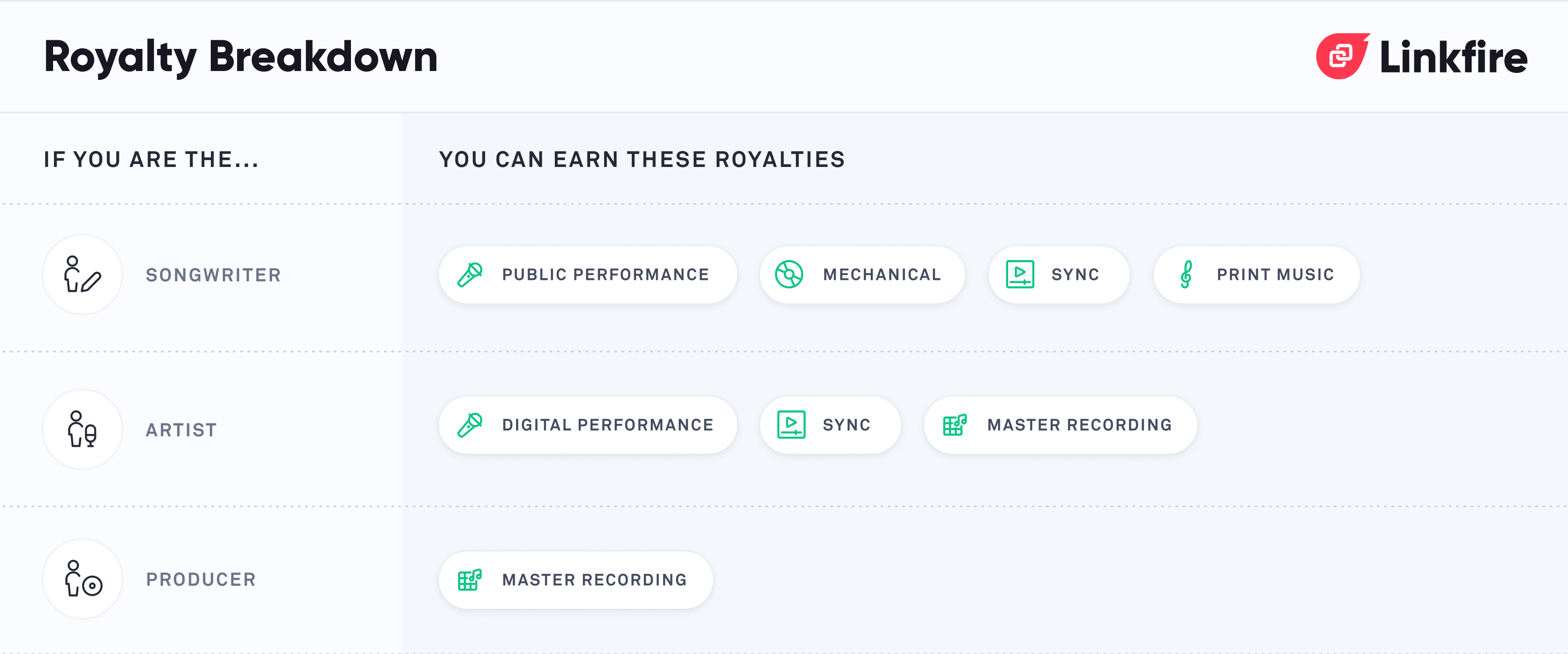
Depending on your role in the music industry, you’ll be able to make money in a variety of ways. If you’re a singer/songwriter, you’ll be earning money on both the recording and publishing sides. If you’re a singer/songwriter/producer, you’re a triple threat. Let’s take a look at those three functions and how each of them is paid.
How do songwriters get paid?
A songwriter is in a great position to take advantage of most of the royalty areas we discussed above. Not only do you receive print and publishing royalties from the underlying song compositions, you also receive mechanical royalties when your song is recorded and released. Keep in mind that that 9.1-cent mechanical royalty is split between you, any co-writers and your publisher.
You’ll also earn a royalty when your song is synced; generally this royalty is split 50/50 between you (the songwriter/your publisher) and the recording artist and/or their label. Finally, you earn performance royalties when your songs are performed live, thanks to those PRO organizations listed earlier.
How do music artists make money?
For simplicity’s sake, let’s assume that the music artist in question is not also the songwriter, since, if they’re a songwriter, they’ll also get paid the royalties mentioned above. As a music artist or recording artist only, you will earn royalties and income on the master recordings of songs. That means they’re paid when that master is synced, performed, or streamed.
Pro tip: Make sure you’re registered with SoundExchange to collect the digital royalties you’ve earned as an artist.
Of course, artists can also earn money in a myriad of other ways that have nothing to do with royalties, such as touring, merch, and sponsorships.
Signed vs. unsigned artists
The music industry has vastly changed in the past decade, and being signed to a label is no longer a make-or-break situation. It’s democratized the playing field for independent artists in lots of ways, and also made it possible for artists to perform many label functions themselves.
One major advantage signed artists still have is getting an advance. This is a recoupable sum of money that a record label will give an artist up front, usually upon signing a deal or at the start of an album/touring cycle. The advance has to be paid back to the label before the artist sees any profits from their music or live shows. After that, the label and artist generally agree on a split royalty structure for money earned.
An unsigned artist isn’t beholden to a label, but they also don’t have that advance cushion or any guaranteed support. It’s no surprise, then, that a lot of artists see their own recorded music as a loss leader—meaning they know they’ll lose money on it, but other means of income such as touring, merch, and licensing will make up for it.
How much you make as an independent, unsigned artist largely comes down to how much time you put into your career, the resources at your disposal, and the opportunities you find or create.
Fee structures
There are two main fee structures to be aware of as a music artist: upfront and revenue sharing.
If you’re signing with a label, you’ll typically earn an advance, which we just mentioned above. That’s considered an upfront fee, and you probably won’t make anything else until that’s recouped.
A share-in-revenue structure from a label or distributor means they only get paid when you do. This incentivizes them to bolster your career with whatever resources they have.
There are pros and cons to both types of structures, so it’s worth considering what’s best for your music career and your overall income stream.
How to make money as a music producer
Like recording artists, producers are typically paid an advance. This, of course, depends on what’s negotiated beforehand, if a label is involved, etc. Sometimes a producer will ask for “points” on the master royalty rate, which means that when a label or artist is paid royalties, the producer will also earn a percentage.
Producers also aren’t beholden to the board these days; many decide to make beats and samples, effectively becoming artists themselves. That opens up a whole other income stream that we’ll discuss more below. Some high-profile producers have created entire brands for themselves based on their beat-making skills.
3. How to increase your chances of making money with music full-time
Before we elaborate on specific revenue streams and monetization ideas, let’s talk approach, process, and strategy. It’s tempting to rush straight for the “get rich quick” ideas or settle for a fantasy of getting randomly discovered on SoundCloud, signing a multi-million-dollar label deal, and riding off in a Lamborghini.
The reality is that gradual, sustainable growth over time—starting with your own DIY marketing work—is the way to create reliable income from your music. Building a foundation that includes an engaged audience of true fans who you know will support your music career long-term is crucial. And in order to do that, you need to devote time to understanding who your core audience is and what they want from you.
Here are a few things you should have in place before you start a monetizing spree:
- An email list. Even with social media, it’s important to have a way to reach your fans directly. Tools like Linkfire’s email capture make it super simple to build your list.
- A social media audience. You don’t need a legion of millions. Engagement is the focus here. If you have a small but mighty band of devotees liking, commenting, and sharing your content, you’ve already got a strong start!
- A measurement plan. Decide how you’ll analyze your results. Money is one way to measure your income, of course. But fanbase growth, increasing streams, even Instagram bio clicks are all important metrics that will help sustain your career in the long run.
A simple way to get yourself in the optimal position to make money with your music is by using smart links. Linkfire caters specifically to artists, and has developed tools to build, bolster, and measure your marketing moves. You can set up your first smart link in just a few clicks, and streamline everything you need to make money from your music.
4. 16 ways to make money with your music
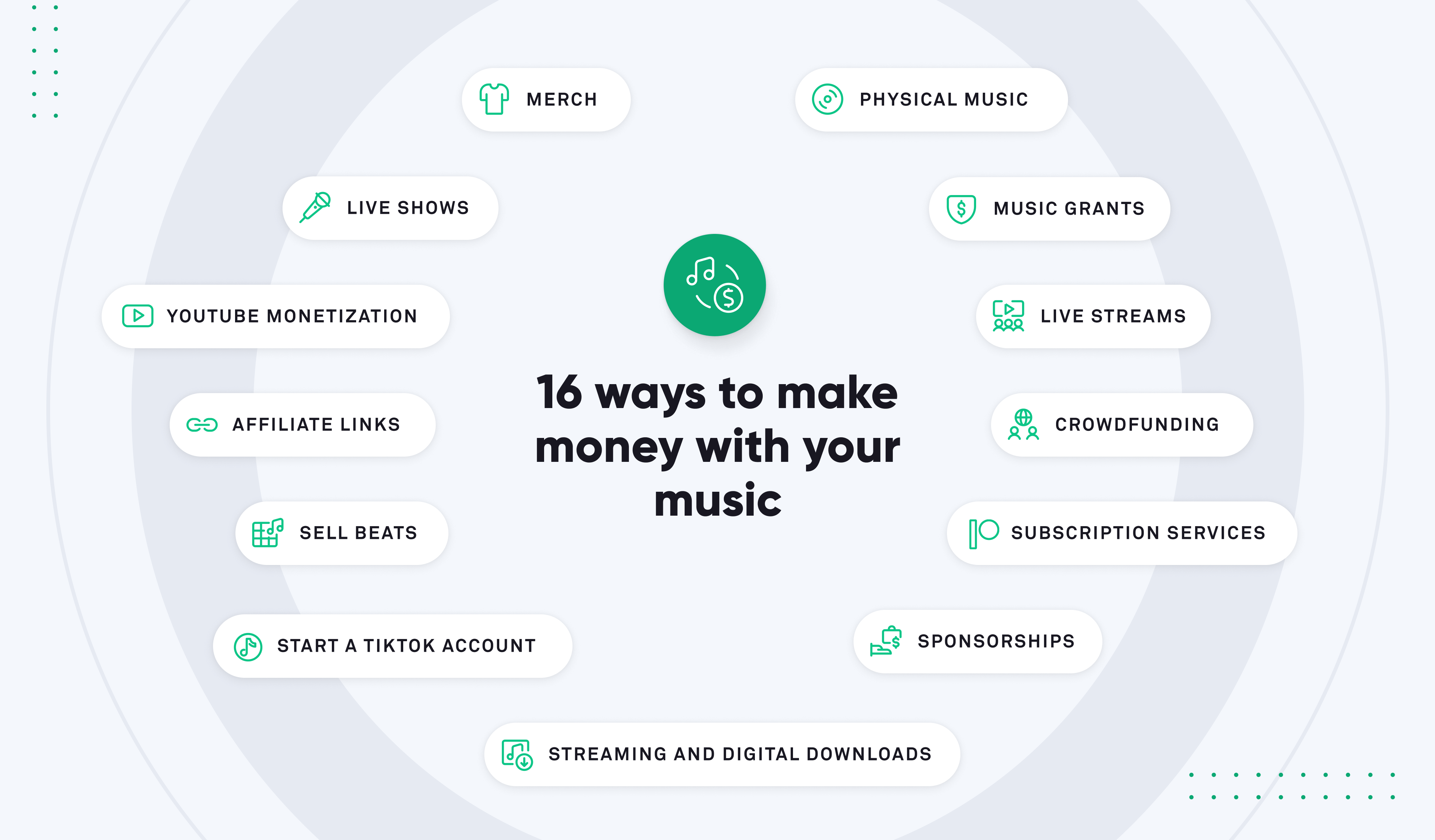
Here are 16 ideas to start making money from your music. It’s up to you to decide which methods might be the most accessible and reliable based on where you are in your music career, your existing fanbase, and the goals you have for the future.
1. Physical music
While some listeners have switched to streaming, there are still plenty of fans who love, collect, and purchase physical media. Believe it or not, in 2021, CDs sales were up for the first time since 2004, with about 109 million sold. Unsurprisingly, vinyl is also hanging on strong since its comeback in the last decade or so; one out of every three albums sold last year was on vinyl. And the sleeper hit? Cassettes. Yes, the next big physical media resurgence might just be perfect for a boombox.
All this to say that it could be worth your time and resources to invest in manufacturing physical media, if you’re at a stage in your career where fans are interested in owning your music. Not to mention that physical music is a cornerstone of any great merch table, and is also a foundational building block of an online merch store.
One note of caution: Take lead times into consideration, as demand and supply chain constraints can mean a long wait for your vinyl.
2. Merch
From the humble band T-shirt to koozies to simple buttons and stickers, fans love to support their favorite artists by… buying stuff. As soon as you recognize that you have a supportive fanbase, try testing the waters by offering a few basic items. Stickers and buttons are pretty low-risk options, and are affordable to make and sell.
Start expanding your merch line as your career progresses and more opportunities warrant different merch items (like concert T-shirts, posters, release-specific merch, etc.).
3. Streaming and digital downloads
Another quintessential income source that you’re hopefully already aware of is making your music available on streaming services like Spotify and Apple Music. This is a great idea whether you’re a baby band or an established artist.
Although per-stream rates are small—a fraction of a cent—if your song is over 30 seconds, you will earn a royalty. These streams do add up over time, and if one of your songs ends up on a major playlist or goes viral on social media, you could be looking at a decent payout.
Digital downloads, on the other hand, might seem a bit antiquated now. But by offering your tracks directly to fans on platforms like Bandcamp with a set price or “pay what you want” structure, you’ll not only be earning significantly more, but your fans will also have a track they can keep forever digitally.
Pro tip: With Linkfire, there’s no need to micromanage all your different streaming and download links. Choose from over 250 services, geo-customize each fan’s journey, and personalize your landing pages to fit your artist brand. Learn more about Linkfire release links here.
4. Live shows
It’s certainly been a strange couple of years for the live music business, but thankfully it seems that music lovers are eager to once again patronize the world’s stages. Live Nation announced that it has booked more shows—some say twice as many—for 2022 as it did in 2019. This is great news for artists who have relied on revenue from their live gigs in the past, and a sure-fire sign to start brushing up on your setlist.
Check out which venues around you are currently booking for the near future, depending on what your draw is as an artist. Stay vigilant as your return to the stage progresses, and use your crowd numbers to play bigger and better venues as you grow.
5. Live concert streams
On the flip side of the true live show are the virtual concert experiences, which obviously have become more and more popular over the past two years. Thanks to platforms like Twitch and Dacast, mainstays like Facebook and Instagram, and unlikely hosts like Zoom, you can now perform for your fans anywhere, from anywhere.
How much you’ll earn is really dependent on your personal model. You have the freedom to decide ticket prices (or a tip jar?), frequency of performances (one-off vs. a virtual residency?), and how you’ll tailor your sets to your fans. Don’t forget this is also a great time to plug your merch, so there are ways to bolster other income streams during your virtual live events.
6. Crowdfunding
What began years ago as a way for creators to ask friends, family, and supportive strangers to fund their idea, event, or invention has now become a stellar way to connect with fans over a common goal. You might find that this becomes a reliable source of cyclical income (e.g., every time you release an album), but it’s not without its share of hard work.
Communication and value building are key to attract and keep supporters interested, so make sure you’re bringing some stellar creativity to make it worth their time and money.
7. Subscription services
Whereas crowdfunding does have that cyclical element, using subscription services like Patreon is a more evergreen style of crowdfunding. Create different tiers so that your more casual fans can get in on the action for even $1 a month.
Host small, virtual concerts for hardcore fans, answer Q&As, or give away signed merch, depending on your fans’ monthly contributions. As your fanbase grows, add more incentives to become a subscriber to really craft a robust strategy.
8. YouTube monetization
Unique from most other social media platforms, YouTube gives music creators a chance to monetize their music not only through ad revenue, but also through product plugs, music promotion, and trackable links in their descriptions.
In order to monetize your YouTube channel, you need 1,000 subscribers and at least 4,000 hours of watch time over the past year. The key here is consistency; set yourself up for success by developing a posting schedule you can stick to. Diversify your content, but make sure your subscribers keep coming back for videos that appeal to them.
As a long-term income strategy, this can be a big one. Every day, people watch over a billion hours of video—so if you continue to grow your channel, you could be looking at full-time income from ad monetization alone.
9. TikTok monetization
Years ago, the social media juggernaut that’s now known as TikTok started as musical.ly, an app where users would lip sync to their favorite songs. Now, it’s a content powerhouse where creators can actually get paid for their viral videos.
Musicians are also taking advantage, and relatively unknown artists are blowing up seemingly overnight (see: Gayle’s smash hit “abcdefu,” which earned over 13 million views on the platform and subsequently landed at the top of the global Billboard charts).
No matter how far along you are in your music career, it could be worth developing TikTok ideas around your songs—especially now that the company has announced SoundOn, a platform that allows artists to upload their songs directly to TikTok and start earning royalties.
10. Affiliate links
Take your #LinkInBio call to action to the next level by using affiliate links. In addition to using your bio link to promote your music, merch, and shows all in one place, you can also use it as a home for your custom affiliate links.
When someone clicks your link and makes a purchase on a website like Amazon, you earn revenue on your side. Pair affiliate links with special posts about why you love the product or service you’re linking to. Learn how Linkfire can help you set up and manage affiliate links.
11. Sponsorships
When you think of sponsorships, a beer sign at a concert might come to mind. But in our tech-laden world, there are many more opportunities for artists at any level to land a sponsorship. It’s always worth asking your local guitar shop if they’d be interested in a partnership promotion, but it’s also highly possible to get hired for some Instagram #sponcon (sponsored content) by your favorite string brand.
You don’t need millions of followers to generate revenue from sponsored social media content; data suggests even “micro-influencers” (those with around 100k followers) can make around $5,000 for a sponsored ad or post. And if you’re not there, don’t worry! Based on your following and engagement, rates are negotiable.
The key here is to have the audience that makes the partnership a no-brainer—so work on building up your socials, with a strong focus on engagement. That way, brands will see that it’s worth investing some ad dollars in a few sponsored posts.
12. Music grants
While probably not an income stream that’s going to be part of your bread-and-butter budget, music grants are certainly possible for a supplemental boost. No matter your level as an artist, how big your fanbase, or what kind of music you make, there are grants from the National Endowment for the Arts along with other private and smaller organizations.
If you’ve been significantly impacted by the COVID-19 pandemic, it’s also important to note the resources available to you, which NAMM has handily compiled. Again, although not a consistent source of income, grants can be a good way to fill in gaps—especially during an unprecedented downtime.
13. Beats, stems, and samples
When you post your music digitally, consider also breaking it down into chunks for usage by other artists. Create stems (the individual mixes that comprise your track), samples (loops or hooks that are particularly catchy), and beat/rhythm tracks that others can buy to incorporate into their own music.
As long as you’ve got the creativity, your success isn’t dependent on your level as an artist. And depending on how you’re choosing to offer your beats (marketplaces like Beatstars and Airbit are a good place to start), you can offer them under either a non-exclusive or an exclusive license (the latter commanding a much higher price). Not only is this a great way to earn some passive income, but it’s profitable—it’s reported that the beat-selling industry earns over $30 million per year.
14. Teaching music
If you consider yourself a pro in some aspect of music (player, songwriter, singer), you may be able to offer your services as a teacher. Consider that 16 million people started playing guitar over the pandemic, and chances are that more than a few of them may need a bit of guidance. If you can set yourself up for a series of lessons, you could add a recurring income stream to your bank account.
Pro tip: Promote your lessons on social media. Fans will surely want to learn your songs from the person who created them!
15. Competitions and contests
If you’re a prolific songwriter, put your talent to use by entering one of the many competitions held annually. ASCAP keeps a running list of current contests, so it’s worth seeing if any appeal to you.
If you’re more of a musician than a songwriter, check out local or regional contests that might offer a cash prize. This is obviously more of a supplemental income source, but could boost your income and your profile at once.
16. NFTs
There’s been a lot of buzz about NFTs (non-fungible tokens) lately, and many in the music industry think they could be a game-changing revenue stream for artists. As with most sources of musician income, NFTs are most promising for those who have a strong fanbase.
You can auction anything from unreleased music to digital artwork in exchange for cryptocurrency. The amount of money you make off of NFT items could range from a few bucks to millions, depending on how supportive your fans are. If you want to give it a shot, here’s how to add popular NFT stores to your Linkfire landing pages.
Final thoughts
Making money from your music isn’t a one-size-fits-all method; there are endless combinations of potential revenue streams for music creators. It’s important to find the mix that works for you and your talents, while keeping your long-term goals in mind.
Linkfire is here to support you every step of the way as you develop new income streams for your music. Use smart links to drive traffic where it matters most, whether it’s pre-saves, summer tour dates, or a fresh merch drop. Sign up for a free trial today.
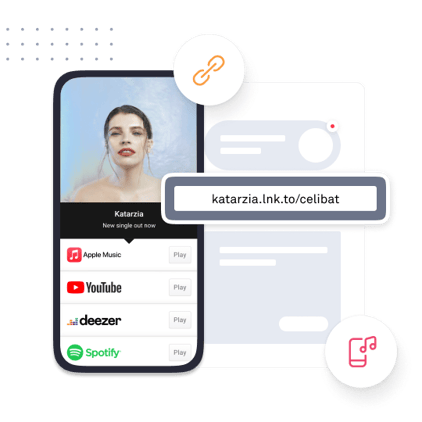
Ready to put these tips to use?
Get eye-catching smart links and landing pages to use in all your music marketing efforts with Linkfire.
Get Linkfire’s curated tips straight to your inbox and become smarter in music marketing. Subscribe to our newsletter.
